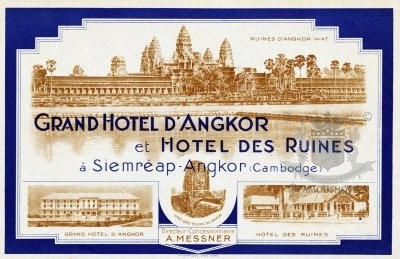

Grand Hotel d’Angkor

At Angkor Wat - like around the pyramids in Egypt - virtually every hotel group of note operates a (sometimes historic) hotel. The most notable hotel is the Grand Hotel, one of the few buildings in Cambodia to have survived the Khmer Rouge regime, becoming one of the country’s most historical buildings.
Since 1931, a visit to the ancient Angkor temples has been synonymous with a stay at the Grand Hotel d'Angkor (and "Hotel des Ruines", its former partner hotel). Now sensitively restored, the hotel is under the wings of Raffles International and shines in renewed elegance and modernity.
The former Royal city of Angkor is the actual target of each traveller. Angkor Wat was built for the king Suryavarman II in the early 12th century as his state temple and capital city. As the best-preserved temple at the site, it is the only one to have remained a significant religious centre since its foundation—first Hindu, dedicated to the god Vishnu, then Buddhist. The temple is the epitome of the high classical style of Khmer architecture. It has become a symbol of Cambodia, appearing on its national flag, and it is the country's prime attraction for visitors.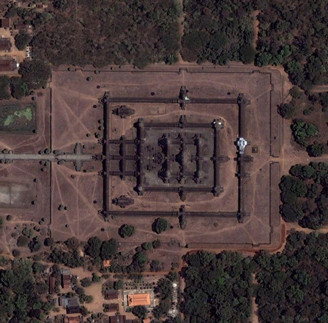
Left: Angkor Wat as seen from the air (googlemaps): a small part of the 8 1/2 x 8 1/2 miles areal of Angkor Wat (or Angkor Vat) - the legendary temple complex at Angkor in the Kingdom of Cambodia.

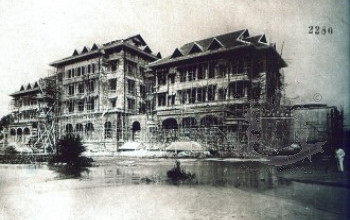

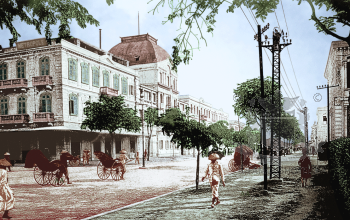

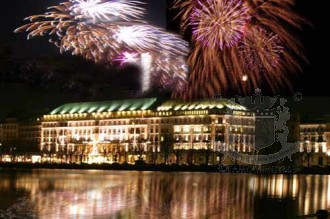
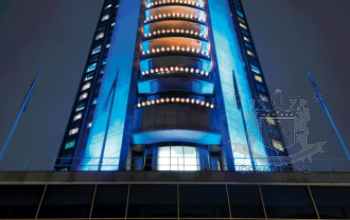

HISTORY IN BRIEF:
1929 the hotel was under construction
1931 opening with 63 rooms all with private bathrooms.
1932, Alfred Messner became director of the „Grand Hotel d’Angkor et Bungalow des Ruines“. In July 1932 Messner was appointed General Manager of the Hotel. The same year Messner produced a guide titled “Archaeological Guide to Angkor“.
In 1933 the Sultan of Johore Sir Ibrahim and his entourage visited Angkor and stayed at the Hotel for two days.
1997: Raffles Grand Hotel d’Angkor re-opened after a complete refurbishment on 30 December. Raffles Grand Hotel d'Angkor was restored and maintained by architect and urban planner, Monsieur Ernest Hébrard.
HISTORY:
Ernest Hébrard, architect and town-planner had inaugurated the Town Planning Service of Indochina in 1923. This office, based in Hanoi, was responsible for the design of many public buildings and urban planning throughout the cities of French Indochina.
The proposal outlined the construction of a 40-room hotel in Siem Reap, conceived to replace or augment the bungalow that could no longer accommodate the needs of the growing number of wealthier tourists.
By the early years of this century, the ruins at Angkor had become a desired tourist destination. As early as 1907, the arrival at Angkor of some 200 tourists in barely three months was noteworthy, and by the late 1920s, the trickle had become a flood. Even during the depression in 1934, it is recorded that 2,817 tourists visited Angkor.
The Grand Hotel d’Angkor originally incorporated 63 to 65 rooms, all with private bathrooms.
1932: The opening of ‘the Grand’
The precise opening of the Grand Hotel is difficult to establish due to the lack of documentary evidence.
From a 1929 document it appears the hotel was already under construction with a projected opening of the some 60 rooms in 1931. Construction appears to have lagged and with the advent of the recession, and the hotel began to function during the 1932 -33 season.
1930s to 1960s: The Heyday of the ‘Grand’ Hotel
British author H.W. Ponder mentioned the newly build hotel in her book, Cambodian Glory, published in 1936. She likened the building style to hotels in Nice, Monte Carlo or the Riviera.
Movie idol Charlie Chaplin and his co-star of ‘Modern Times’, Paulette Goddard were among the long list of famous visitors to Angkor. The wealthy, EFEO archaeologist and art historian, Victor Goloubew (1878-1945) hosted their April 1936 visit to the ruins.
The hotel offered an array of services for the visitor, such as torch-lit Khmer dancers accompanied by traditional musicians at Angkor Wat, elephants for excursions, motor tours, interpreters and guides. Ponder also noted a large area to the rear of the hotel had been cleared and leveled by the manager for golf - a small private course that was added for the further enjoyment of guests.
The early Sihanouk era during from 1955 to 1965 saw immense growth within the country - a fervent striving for international recognition and a modernisation program that saw the province blossom. Tourists, international dignitaries and the rich and famous once again came to marvel at Angkor. President Charles de Gaulle visited in 1966 and the former wife of the late President Kennedy, Jacqueline Kennedy Onassis in 1967. Princess Margaret and her husband, Lord Snowdon also visited the ruins in 1969.
1990s to the present day: A ‘Grand’ Life
The Grand Hotel d’Angkor began to function again as a hotel between December 1991 and October 1994. One of the most important functions held at the Grand Hotel in the last years prior to closure for renovations was a VIP Luncheon on 5 August 1992. Hosted by HRH Prince Norodom Sihanouk and UNTAC leader, Yasushi Akashi, the guest list included diplomats, UNTAC representatives including, Gen. John Sanderson, SNC leaders - Hun Sen, Khieu Samphon, Ieng Mouly, HRH Prince Norodom Ranariddh, with SOC, KP, FUNCIPEC and DK leaders. This luncheon, with a host table and eightguest tables, was to announce the UN-sponsored elections to be held in Cambodia during May 1993.
Raffles International Limited began renovation work on the hotel in March 1996 and Raffles Grand Hotel d’Angkor re-opened after a complete refurbishment on 30 December 1997. The hotel now boasts a total of 119 rooms.
The cool, uncluttered lobby reflects the understated elegance of the hotel. Corridors extend, seemingly to vanishing points, in either direction as if reflected in countless mirrors. In sympathy with the original building, the Conservatory has been added to extend the lobby area and to provide a spacious lounge for cocktails. It overlooks the garden and poolside terrace. Metalwork from one of the original main doorways to the hotel is to be found framing the entrance and marble stairway that leads downstairs from the ground floor to the basement Elephant Bar.
A new wing that perfectly replicates the architectural style of the main building has been added to the west and three small villas, one housing the spa, to the east of the swimming pool. All are set amidst lush, tropical gardens. The hotel also maintains an outdoor performance house used for cultural performances. This is set diagonally opposite the hotel in the public riverside gardens. A stage for similar shows can be found in the hotel’s private gardens to the rear o f the poolside pavilion.
Along with the hotel, Raffles Hotels & Resorts has undertaken the restoration and refurbishment of the park that extends from the hotel to the main road incorporating the formal gardens, now named the ‘Royal Crusade for Independence Gardens’. This fan -shaped park forms an imposing frontage to the hotel and is shared by the populace of Siem Reap. The garden complex, in addition to the formal garden, consists of an area devoted to the sacred Buddhist flower - the Lotus gardens, the River gardens along the bank of the Siem Reap River and the Temple gardens. In 1998, Raffles Hotels &
Resorts also restored the 1928 Art Deco-style bridge that spans the river.
Period architectural details abound throughout the hotel to delight the visitor. From the ironwork surrounds of the cage elevator, now beautifully restored to its former glory (the lift once again silently ferries guests to the upper floors) to the floral-motif Art Deco railings on the floors above extending to the staircase rail. The metalwork has been carefully restored to its former pristine elegance. The wide eaves of the huge tiled roof are supported at regular intervals by large, tiered concrete supports. These brackets emulate those made of wood that are usually seen bearing the immense weight of Chinese palace or temple roofs.
The light of the moon promises one of the most beautiful views of the hotel. The soft warm glow of the Conservatory with guests and staff in silhouette, the main building with balcony lights reflected in the inky, glass-like surface of the pool unites in a spectacular panorama of ‘the Grand’ by moonlight.
the list will be published shortly here on famoushotels.org
When in 1932 Alfred Messner was appointed General Manager of the hotel, he produced a guide titled “Archaeological Guide to Angkor“. It wasn't uncommon for hotel managers to produce a little guidebook for their guests, as they knew best what their clientèle was interested in. Today publishers produce "destination guids", and smart hotelliers sell the history of their hotels as a book.
Christian Sack
Alex Kassatly, Robert Hauck (-2011)
119 Rooms